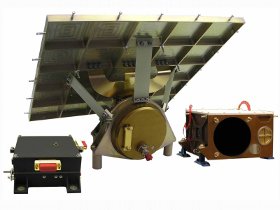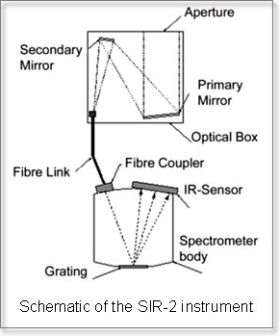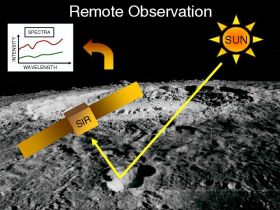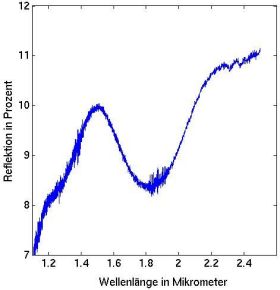
|
Chandrayaan - SIR-2
|
 |

|
Chandrayaan - SIR-2
|
 |
 The SIR-2 instrument is an infrared spectrometer build for remote sensing of the lunar surface. SIR-2 (Spectrometer InfraRed) represents the German scientific contribution to the Indian Chandrayaan-1 lunar mission. The project is funded by the Max Planck Society (MPS) and partly by the European Space Agency (ESA) in collaboration with the University of Bergen (Norway) and the Polish Academy of Science.
The SIR-2 instrument is an infrared spectrometer build for remote sensing of the lunar surface. SIR-2 (Spectrometer InfraRed) represents the German scientific contribution to the Indian Chandrayaan-1 lunar mission. The project is funded by the Max Planck Society (MPS) and partly by the European Space Agency (ESA) in collaboration with the University of Bergen (Norway) and the Polish Academy of Science.
|
|
Science Objectives |
|
|
The Instrument |
|
|
The Science behind the project |
|
|
Learning from lunar near-infrared spectra |
|
|
Related links |
|
|
SIR Home Page at MPS |
|
SIR publications by MPS members |
The SIR-2 is a redesigned, highly compact, monolithic grating, near-infrared spectrometer operating in the wavelength range from 0.9 to 2.4 micrometer with a spectral resolution of 6 nanometres and >100 S/N. The reflected light from the Moon is focused onto a fibre, which leads the light to the spectrometer body. At the grating the light is dispersed and then detected by an IR sensor across 256 pixels. Each pixel is a photodiode converting the incoming light into an electronic signal.
 Figure 2. Schematic of the SIR instruments.
Figure 2. Schematic of the SIR instruments.
Since the SIR-2 is a footprint spectrometer, each spectrum represents the surface characteristics of an ellipse whose size is defined by the opening angle of the instrument and the distance between the spacecraft and the ground, in this case around 220 meters.
Every planetary surface consists of different minerals and of the rocks they form. On the Earth the rocky surface is nearly everywhere covered by soil, a mixture of eroded rocks and organic remains. With no biosphere on the Moon the lunar soil is pulverized rock, but the processes of erosion are quiet different from those on Earth. Since we cannot go and take samples from all surfaces in our solar system to investigate their composition, we use the characteristic features which those minerals imprint on the reflected light from the Sun to identify them from space. Some portions of the solar spectrum are more strongly absorbed and scattered, and thus less reflected than others by minerals. In those wavelength regions we see a dip in the reflected light that we call an absorption band. One can compare it to the unique fingerprint every human being has. The near-infrared is extremely well suited for identifying minerals from space because the most abundant and common minerals in the solar system show characteristic absorption features in this wavelength range which clearly distinguishes them from each other.
 Figure 3. Principle of Remote Sensing.
Figure 3. Principle of Remote Sensing.
In the figure below an example for a near-infrared spectrum is given. A Lherzolite rock piece was pulverized and examined with an infrared spectrometer. Olivine and Pyroxene are the major minerals in this rock type, and together with Plagioclase these three minerals are the major minerals on the lunar surface and in the solar system. In a mixture of minerals the different features are superimposed on each other, but not necessarily in a linear way. Depending on the chemical composition pyroxenes show absorption bands around 1 micrometer or around 1 and 2 micrometer(s) in the near-infrared while Olivine has a broad-band around 1 micrometer. Since our Lherzolite rock contains of Olivine and Pyroxene its spectra exhibits a Pyroxene band at 1.8 micrometers and a band at 1 micrometer, from which we can only see the drop to a shorter wavelength. This 1-micrometer band is a mixture of the 1-micrometer band of Olivine and that of Pyroxene. With the SIR instruments spectra of this kind are taken all along the orbit between 0.9 and 2.4 micrometers.
 Figure 4. Reflectance spectra of a Lherzolite stone powder.
Figure 4. Reflectance spectra of a Lherzolite stone powder.
Three major pieces of information from which we can draw conclusions about the surface composition and the surface age are confined in the spectra of reflected sunlight in the near-infrared.
With the technique of remote sensing one is able to obtain information from the upper micrometers of the surface only. To learn about the three-dimensional structure of the Moon we can take advantage of the huge impacts in which the Moon was exposed to in the last 4 billion years, which brought material from a larger depth into our reach. The peaks of large impacts are known to expose material from several kilometers depth, and the lavas in the mare represent molten material from the source regions up to 300 km depth. Using those tools we can study not only the surface of the Moon but also a part of its inner structure. In this respect we learn about its history and because the formation of the Moon is closely interwoven with the formation of Earth we also learn more about our own planet.
|
SIR Home Page at MPS |
|
|
Chandrayaan-1 Mission page at the Indian Space Agency |
|
|
Smart-1 page at ESA |
| © 2009, Max-Planck-Institut für Sonnensystemforschung, Lindau |
Urs Mall 29-09-2009 |